Accepted Scientific Name: Encephalartos lehmannii Lehm.
Nov. Stirp. Pug. [Lehmann] 6: 14 (1834). Monv.
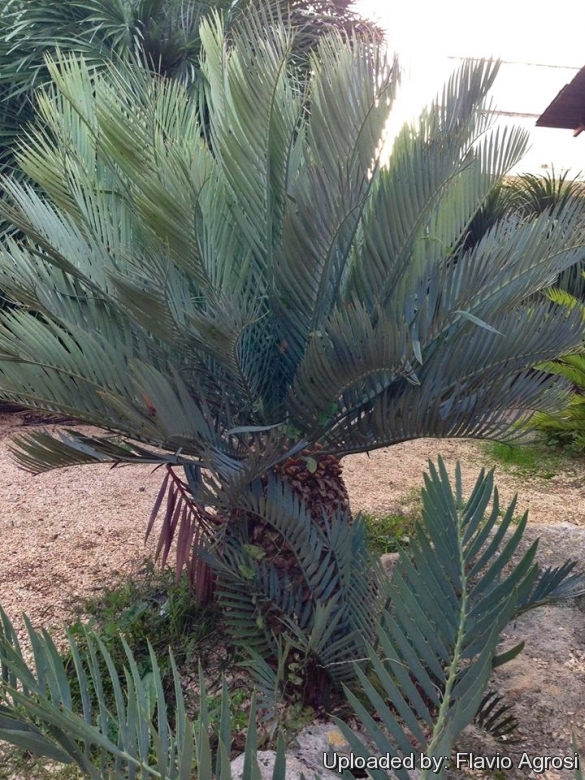
Zamia lehmanniana (Encephalartos lehmannii) Photo by: Flavio Agrosi
Origin and Habitat: Encephalartos lehmannii occurs in the Karoo area, of South Africa (Eastern Cape Province in the districts of Willowmore, Jansenville, Pearston, Somerset East, Kirkwood, Uitenhage and Steytlerville. It grows on the Grootrivier Mountains, the Klein Winterhoek Mountains, the Groot Bruintjieshoogte Mountains and the foothills of the Groot Winterhoek Mountains in the drainage areas of the Groot and Sundays Rivers.) This species tends to occur in subpopulations of several hundred plants across its range.
Altitude range: Occurs at altitudes ranging from 400 up to 1,000 m.
Habitat and Ecology: This species usually grows on mainly on dry sandstone hills and mountainsides amongst low succulent herbs and Karoo shrubs. The climate in its distribution area is dry, with very hot summers. The rain falls mainly in summer and the annual rainfall is seldom higher than 350 mm. By flourishing in such an arid environment it demonstrates how the cycad race has endured through the ages, seemingly immune to drought when many other tree species are leafless and sometimes dead. Plants appear to be sensitive to heavy browsing by goats and mortality of adult plants is common where goats are farmed. Drought has had an affect in the past. There have been fewer coning episodes and porcupines have damaged stems in search of food. To a lesser degree, plants have been lost due to over-collecting by poachers. It is often associated with Encephalartos cycadifolius.
Synonyms:
See all synonyms of Encephalartos lehmannii
back
Accepted name in llifle Database:Encephalartos lehmannii Lehm.Nov. Stirp. Pug. [Lehmann] 6: 14 (1834).Synonymy: 9
back
Common Names include:
ENGLISH: Karoo Cycad, Blue-leaved cycad
CZECH (Čeština): Píchoš Lehmanův
Description: Encephalartos lehmanniiSN|29831]]SN|29833]], commonly known as the Karoo cycad, is one of the hardiest and most drought-resistant South African palm-like species, that slowly grows up to 2 m tall. It often suckers and seedlings may form clusters of 8–10 plants together. New leaves are bluish-grey, older leaves dark grey. It bears a single cone with a green background that appears blackish-red with green around the margins.
Distinguishing characteristics: It leaves are glaucous when young with well spaced leaflets. There seems to be a confusion in the naming of this species as there are some with lobed leaflets, whilst others are found with only small marginal spines, or are entirely without these spines.
Derivation of specific name: The species name "lehmannii" commemorates Prof J.G.C. Lehmann, a German botanist who studied the cycads and published a book on them in 1834.
Trunk: Branched from the base or unbranched, 1.5-1.8 m tall (rarely up to 2 m) and 25-45 cm in diameter with persistent broadly ovate, acuminate leaf-bases.
Leaves: Up to 90-150 cm long, including petiole up to 25 cm long, glabrous, erect or slightly recurved, markedly glaucous (blue or silver) when young but becoming dark green and strongly keeled. The leaflets are lanceolate, in V disposition, well spaced on the rhachis (do not overlap each other, but more closely set in the upper half) the middle ones the largest, entire or lobate-dentate, very pungent-pointed, linear or linear-lanceolate, the middle ones up to 18-20 cm long and 18-20 mm broad (excluding the teeth), very obscurely or not even visibly nerved and reduced in size possibly to one prickle at the base. Margin smooth or very rarely toothed, the 1-2 teeth when present mostly on the lower margin and near the middle or towards the top. Cycad leaf development is very fern-like; fronds uncoil from fiddleheads, and in Cycas, so do the leaflets. In fact, it is perfectly correct to refer to cycad leaves as fronds and their leaflets as pinnae.
Cones: Solitary, on short stout peduncles, blackish-red because of short dense blackish hairs on the terminal half of the bulla face or sometimes greyish on the terminal facet.
Male cones: Subsessile, slender, cylindric, tapered towards the base, yellow-green or brown and up to 22-35 cm long and 5-10 cm in diameter; scales numerous, with a small suborbicular or quadrangular shortly strigillose-pubescent top.
Female cones: Similar colour, short, broadly oblong-ellipsoid, and 30-50 cm long and 15-23(-30) cm in diameter. Scales at length ruddy brown, with a broadly ovate-acuminate limb and small truncate orbicular top.
Seeds: Red and up to 4.5-7.5 cm long, including the aril angled by compression,.about 2 cm in diameter, with fleshy beak.
Related species: Encephalartos lehmanniiSN|29886]]SN|29833]] forms a group with Encephalartos horridusSN|29902]]SN|22844]], Encephalartos latifronsSN|29829]]SN|29829]], Encephalartos arenariusSN|22844]]SN|29902]], Encephalartos longifoliusSN|29833]]SN|29886]] and Encephalartos trispinosusSN|29833]]SN|29831]]. These species occur in a relatively small area in the Eastern Cape Province of South Africa, usually in dry conditions. They carry solitary cones, and several of them have markedly glaucous leaves and/or very prominently spiny-lobed leaflets. None of them has prickles on the petiole.
Bibliography: Major references and further lectures
1) Donaldson, J.S. 2010. "Encephalartos lehmannii." The IUCN Red List of Threatened Species. Version 2014.3. <www.iucnredlist.org>. Downloaded on 11 December 2014.
2) Eve Palmer, Norah Pitman “Trees of Southern Africa, covering all known indigenous species in the Republic of South Africa, South-West Africa, Botswana, Lesotho & Swaziland” Volume 1 A. A. Balkema, Cape Town 1972
3) Dr J.P. Roux “Flora of South Africa” 2003
4) Loran M. Whitelock “The Cycads” Timber Press, Portland OR 2002
5) Keith Kirsten “Gardening with Keith Kirsten” Struik, 10 September 2001
6) Umberto Quattrocchi “CRC World Dictionary of Medicinal and Poisonous Plants: Common Names, Scientific Names, Eponyms, Synonyms, and Etymology” (5 Volume Set) CRC Press, 03 May 2012
7) Fred Donald Rauch, Paul R. Weissich “Plants for Tropical Landscapes: A Gardener's Guide” University of Hawaii Press, 2000
8) Cape of Good Hope (South Africa). Dept. of Nature Conservation “Report - Republic of South Africa, Provincial Administration of the Cape of Good Hope, Dept. of Nature Conservation” Eds 9-15 1952
9) J. Hutchinson & Rattray “Flora Capensis,” Vol 5, Part 2 (Supplement), page 24, (1933)
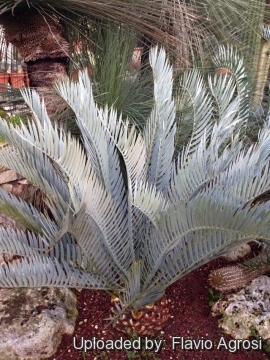 Zamia lehmanniana (Encephalartos lehmannii) Photo by: Flavio Agrosi
Zamia lehmanniana (Encephalartos lehmannii) Photo by: Flavio Agrosi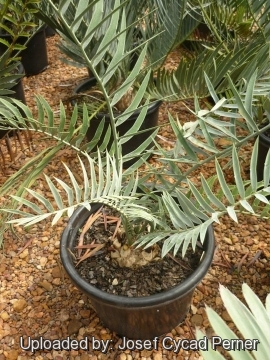 Zamia lehmanniana (Encephalartos lehmannii) Photo by: Josef Cycad Perner
Zamia lehmanniana (Encephalartos lehmannii) Photo by: Josef Cycad Perner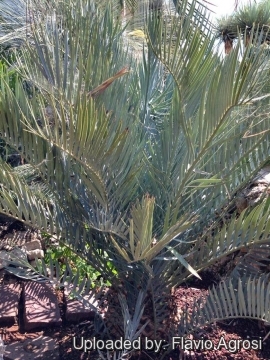 Zamia lehmanniana (Encephalartos lehmannii) Photo by: Flavio Agrosi
Zamia lehmanniana (Encephalartos lehmannii) Photo by: Flavio Agrosi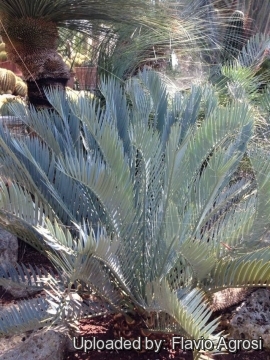 Zamia lehmanniana (Encephalartos lehmannii) Photo by: Flavio Agrosi
Zamia lehmanniana (Encephalartos lehmannii) Photo by: Flavio Agrosi Zamia lehmanniana (Encephalartos lehmannii) Photo by: Flavio Agrosi
Zamia lehmanniana (Encephalartos lehmannii) Photo by: Flavio Agrosi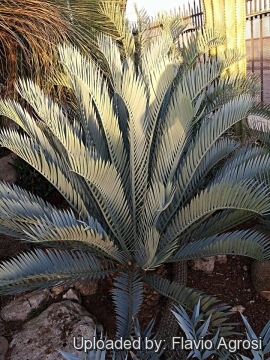 Zamia lehmanniana (Encephalartos lehmannii) Photo by: Flavio Agrosi
Zamia lehmanniana (Encephalartos lehmannii) Photo by: Flavio AgrosiCultivation and Propagation: Encephalartos lehmanniiSN|29833]]SN|29833]] is an adaptable plant well suited to warm temperate and subtropical climates, and can handle light frosts. With its bright foliage heightened by full sun is a commanding accent plant in the general landscape and makes an excellent tubbed specimen. It can be grown in full sun without its leaves burning. Its colour makes it a good subject for the nightscape. Its beauty and ease of horticulture make it one of the finest cycads for use in the garden. It is partially drought tolerant, salt tolerant, and completely wind tolerant. As a garden plant, this cycad will usually hold one or two crowns of leaves, all in good condition. As a seedling, it often loses its previous year's leaves before the new leaves emerge. The seedlings need plenty of room for the tap root to develop and require very good drainage.
Growth rate: It is a long lived slow growing plant taking 15 to 20 years for one of these to produce a cone, so patience is a must.
Soils: It responds well to deep, fertile, slightly acidic, well drained, soil enriched with compost.
Waterings: In cultivation prefers plenty of water, especially in dry weather for optimal growth. But it is eventually drought resistant.
Fertilization: Naturally undemanding for nutrients, it responds very well to regular applications of fertilizer. Growth can be greatly improved through the application of fertilizers. Most growers find that a fertilizer having an even NPK (Nitrogen, Phosphorus, Potassium) balance, and supplemental trace elements, provides a good start for cycads.
Exposure: It will grow in partial shade, however best results are obtained growing the seedlings in full sun.
Warning: Seeds are poisonous.
Hardiness: They do best in a tropical or sub-tropical climate and should be kept totally dry in winter at or around 10°C but demonstrate a remarkable degree of cold resistance and may tolerate light frost for short periods if dry, however heavy frosts would probably be fatal.
Propagation: Plants are available from nurseries in many areas, however they are also easy to propagate from seeds. They can also be propagated from suckers with some patience and experience.















